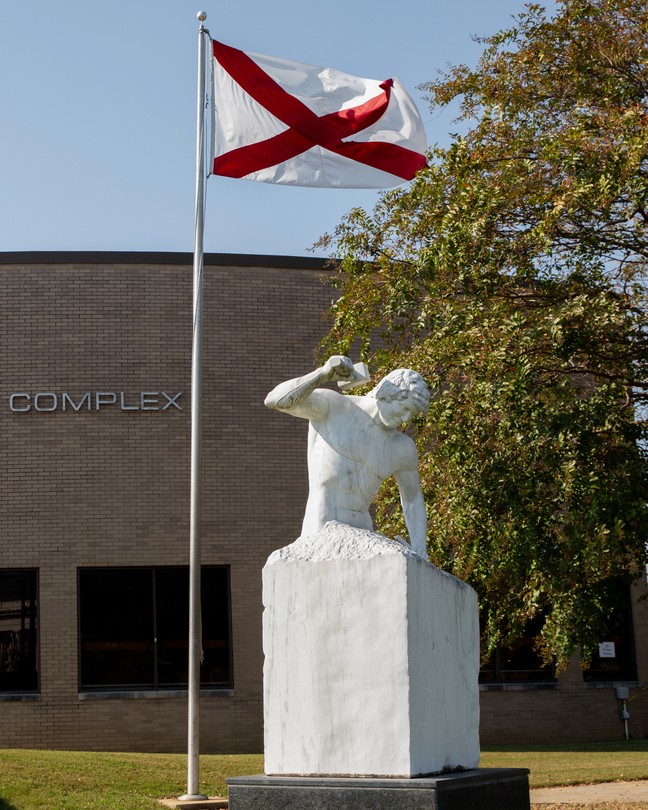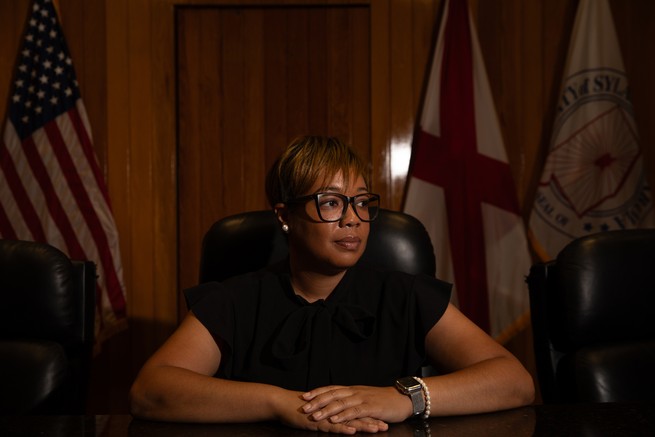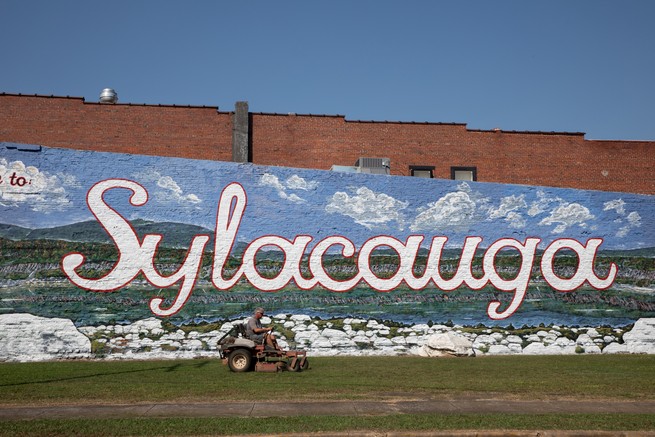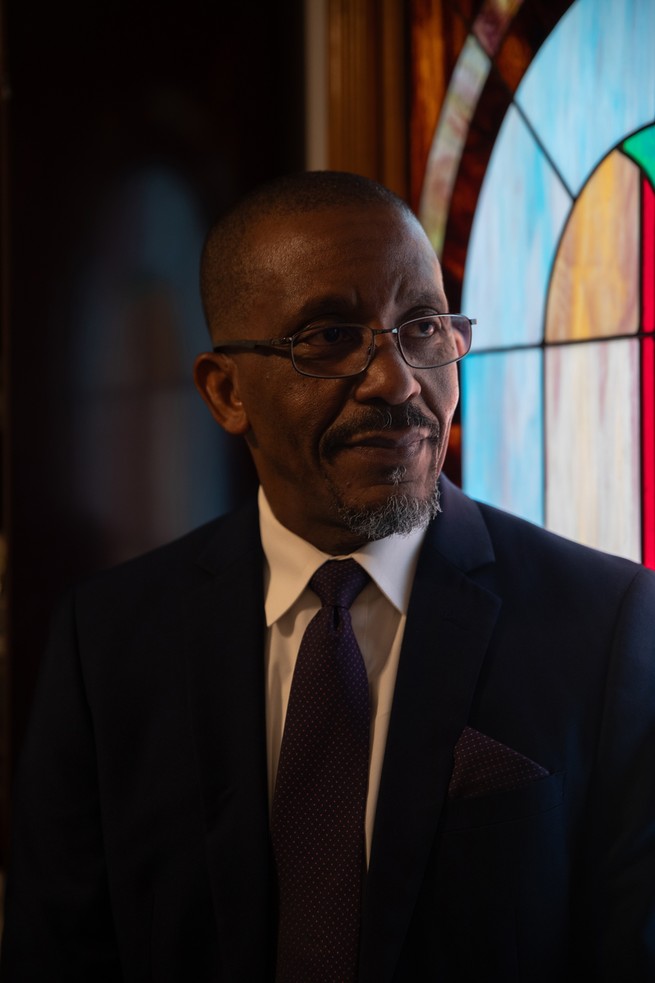The Invasion That Wasn’t
16 min read
The Haitians had come to Sylacauga by bus.
Two buses—possibly even three. But certainly more than one; of this, one resident was sure. As he explained on Facebook, he’d been told by someone who’d spotted them unloading in the Walmart parking lot.
The federal government had chartered their transport, locals were saying—an effort to cripple the welfare state of this small Alabama town as punishment for voting red. “Follow the money,” one suggested. The city council had known that they were coming; actually, it was the mayor who’d taken the bribe money from Washington, who’d quietly transformed Sylacauga into a sanctuary city while praying that his constituents wouldn’t notice.
But they had noticed. Members of a local Facebook group devoted to “Things Going On in Sylacauga” knew about the 750-plus FEMA trailers coming in to house the new migrants (“Talk in the barbershop is more like 1500”); they knew about the shelter being built in nearby Childersburg for the others still to come. “It’s about time we said something about this invasion,” one resident declared.
On September 17, a Sylacauga city-council member named Laura Barlow Heath briefed the nation on Fox News. “There is a fear here of becoming the next Springfield, Ohio,” she said. “You know, when is enough enough? When do they stop coming in?” The town is a fraction of the size of Springfield—just over 12,500 people—and without answers, Heath stressed, “civil unrest” was imminent. At a city-council meeting that night, a resident named Charles Mackin said the local Walmart had come to feel more like a “Third World airport”; he worried about hotels and apartment complexes being taken over. “If you can’t stop that, then we’re going to have to stop it,” he told the council. “You understand?”
The truth was that local and state officials didn’t know much more about the Haitian migrants than the residents themselves—their legal status, their path to Alabama, or even how many had come. Conspiracy theories bloomed in the void. When officials began deconstructing the rumors—pointing out that there was no FEMA trailer park or migrant shelter; that the buses in the viral photo on social media contained a high-school football team en route to an away game; that the “influx” consisted of a few dozen migrants who’d come legally to work, mainly at nearby auto-manufacturing plants—many locals called it a cover-up. By then, they had already pledged their fidelity to a story: Sylacauga was the victim of a Haitian sortie orchestrated by city leaders in concert with the Biden administration, a conspiracy all the more alarming for its proximity to the presidential election.
I grew up just under two hours from Sylacauga—a town best known, or at least known to me, as a flagship of Blue Bell Creameries—and thought it curious that for all the declarations of invasion, there seemed to be very few dispatches from the front lines. And so at the end of September, I went to observe for myself this community on the trembling edge of civil unrest. What I found was one small house on South Main Avenue with air mattresses in the living room and no table in the kitchen, a single new student in the school system, and six Haitians in a church pew.
Most of the Haitians came to Sylacauga in June, but not until August did anyone seem to care.
That was when residents of Albertville, 85 miles to the north, posted photos online of charter buses picking up and dropping off Haitian migrants at “odd hours” around town. For years, Haitians had lived without incident in Albertville, but the buses were new, and rumor had it that they were coming from out of state; in fact, city leaders quickly determined, they were transporting employees of a poultry processor to and from work. Residents called on Jay Palmer anyway.
Palmer, an Alabama native, describes himself as a whistleblower and “former Trump immigration adviser,” though I struggled to find any evidence of an association with the former president. (“I can’t really go into a lot of details,” Palmer told me. “There was a program we were going to start, and that’s really all I’m going to say.”) Since mid-August, he has been on a kind of fearmonger’s tour of the state. “This is not happening just because they chose to come here,” he assured a church gathering in Albertville. “They were sent here.” This was about “votes” and “cheap labor,” he explained, and he urged “good Albertvillians” to stay vigilant.
The hysteria in Albertville breached city limits in the weeks that followed, sweeping through communities across Alabama where Haitian migrants had been spotted, and some where none appeared to be living at all. Then it landed in Sylacauga.
Not even Mayor Jim Heigl can identify the precise moment when things changed, the event or sighting or imagining that triggered the flurry of calls from residents demanding to know if Sylacauga had become a sanctuary city. He cannot say for example why one woman felt suddenly moved to park in front of the house on South Main and hold her phone just high enough above the dash to film six Haitian men as they sat in the front yard, talking. (“Across from the daycare,” she’d captioned the upload on Facebook.)
Truth be told, Heigl, a pleasant and drowsy-eyed man in his 80s, preferred not to say anything about the past eight weeks at all. It wasn’t fair, how people had portrayed his hometown. Hernando DeSoto had traveled through the area, and also did I know about the calcium carbonate? “Backbone of our city,” he said proudly. Sylacauga’s sister city, Pietrasanta, Italy, has white marble too, he noted, but it’s not as dense as Alabama’s, so the Italians “really enjoy coming and working with our marble.”
Anyway, all Heigl could say for certain about what had gone wrong—what had led to the city-council meeting on September 5 that pitched Sylacauga into the national spotlight—was this: Some people “crawled out from under a rock and smelled something. And then they just ran with it.”

“We knew that people were going to come,” Tiffany Nix, the council president, later told me about that meeting. “But we never expected what happened to happen.”
The evening began calmly enough. After signing off on the city’s accounts-payable invoices for the fiscal year, Nix opened the floor to public comment. A woman approached the lectern. “I have a couple of questions,” she said, “about the ‘legal immigrants’”—here she gestured with scare quotes—“that we’ve had come to our city.” She wanted to know how they’d been vetted, where they were living. “Who is heading up, watching over this situation?”
The council didn’t have any information, Nix said, beyond the fact that the migrants were here legally. But Mary Deason, next at the mic, was not satisfied. “My question is, if they’re being bused in here, brought in here by vans, how come the city knows nothing about them?”
“Ms. Deason, with all due respect—” Nix began. “Has anybody seen any bus coming in here, dropping people off?”
Deason: “I see why nothing gets done in this town.”
Then came Darryl Philips, who found the council’s attitude “entirely unacceptable”: “Do we know where the individuals we’re discussing are coming from? Their point of origin? Because you’re treating them like lawful U.S. citizens, which they are not—”
“Okay, so I’m going to cut it off,” Nix said, “because we have no reason to launch an investigation, or to treat people differently because of how they look.”
“Who said that?” Philips asked. “I didn’t say that.” Crosstalk erupted; Nix, who is the only Black person on the council, and Councilwoman Heath started arguing; Philips kept going. “Haiti is a failed state,” he said. “There’s no way the State Department can vet these individuals.”
It was at this point that a man from the audience walked up and planted himself next to Philips, crossing his arms and glowering at Nix. A woman shouted at her, “You shut up and let people talk.” Nix later told me that the footage from the event didn’t capture the scope of the scene: Just out of the frame were more people who’d stood up from the audience, arms crossed and glares set, something she interpreted as “a show of force.”
Nix asked everyone to leave; the meeting was over.
“Good to know they don’t want to hear the truth,” one resident said.
Nix had a police officer escort her to her car.
The clips went viral on TikTok. Within days, Philips was on Fox News. “Alabama Resident Reacts to ‘Totalitarian’ Council President Disbanding Meeting Over Migrant Questions,” the headline on the accompanying article read.
Over the next two weeks, officials pieced together what information they could. Between 25 and 60 Haitian migrants were living in Sylacauga; the school system had just one new enrollee. Many of the migrants had found jobs through staffing agencies, settling into three-month roles with auto-manufacturing plants outside town. A number had already moved out to a motel in nearby Alexander City for an easier commute.
According to officials, many of the migrants numbered among the 210,000 Haitian nationals who have entered the U.S. since January 2023 under the Biden administration’s parole program for Cubans, Haitians, Nicaraguans, and Venezuelans. “Parolees” can live and work in the U.S. for up to two years with the support of a U.S.-based sponsor, who agrees to help with housing, health care, and other needs for the duration of their stay. The program was suspended for much of the summer after federal investigators found signs of fraud—thousands of so-called serial sponsors, two dozen of whom had applied with Social Security numbers belonging to dead people.
Facts about the Haitians in Sylacauga were parceled out by officials in subsequent city-council meetings. Yet there were things the local officials just didn’t know, including who the migrants’ sponsors were, and how to make sure they were fulfilling their obligations.
For some residents, including church leaders, the push for answers sprang from genuine concerns about labor trafficking. (Following a late 2022 report that auto plants in rural Alabama were employing children, many of whom were migrants, the Department of Labor filed suit earlier this year against three Alabama companies for violating federal child labor laws.) Others saw the absence of information as more proof that the government was abetting the “invasion” so clearly under way.
For the conspiracy-minded, vindication came with the collision of two events. The first was the arrest of one of the migrants outside the house on South Main on September 8 for allegations of domestic violence—which was seized on by people who were already arguing that the Haitians were corrupting the town. The second was the vice-presidential nominee J. D. Vance, and then Donald Trump, spreading the baseless conspiracy theory that Haitians were eating pets in Springfield, Ohio.
Virtually every Republican official in Alabama seemed to want a piece of the Springfield conspiracy—they, too, had Haitians in their communities, and they, too, were supposedly facing a crisis. “This sudden surge of people has created safety, health, infrastructure, and economic concerns for residences,” Senator Tommy Tuberville wrote to the secretary of homeland security. “This situation is simply untenable.” The lieutenant governor wrote his own letter to DHS, falsely claiming that the “HIV rate is soaring” as a result of “illegal aliens.” On September 19, Alabama’s attorney general traveled to Sylacauga to offer assistance.
“It was embarrassing,” Mayor Heigl told me. “He met with our county’s task force, he met with the sheriffs, he met with all our police investigators, everything—and he could not find anything wrong.”
And yet that very evening, there Sylacauga was on prime-time Fox, Laura Ingraham featuring the small town as the latest “target” of the Biden administration’s “open borders” agenda. She rolled clips from the latest city-council meeting, featuring a resident’s protests that his rights were being “trampled on.” She warned Americans to pay attention. “This is a flood of humanity … and it will be at your doorstep soon.” Then she offered a definitive explanation for what was happening: “Sylacauga is Trump country. They aren’t fans of DEI programs, they don’t believe much in gender fluidity, and they do respect and support law enforcement. And we know what [Kamala] Harris thinks of people like that,” Ingraham said. “It’s all a form of punishment.”
Lost in all this were the Haitians themselves. Throughout my week in Sylacauga, I tried to speak with them. Eventually, the six I met at Sylacauga First Baptist Church—men who ranged in age from their mid-20s to their 50s—agreed to talk, but only if I didn’t publish their names, because they didn’t want to draw any more attention to themselves. They spoke only Haitian Creole, so we communicated through a translator. They told me they’d gone to a Protestant church back in Haiti and had been glad to find one here.
Rick Patrick, the church’s lead pastor, and Tripp Dickson, the family pastor, told me they had been trying to learn more about the new congregants; they wanted to know how the church could help ease their transition. One Sunday, Dickson had invited them to his office after the service. But it was difficult to convey all that to people who didn’t speak the same language. Finally, one of the migrants responded with some of the few English words he did know: “God is good.”

Ingraham’s theory of punishment validated what many residents had long suspected, at times seemed even to want to be true: that Sylacauga was the express target of some undisclosed plan from on high. There was order in conspiracy; the notion that the migrants’ arrival might simply be a function of the scattered and banal physics of human life—a guy knew a guy who knew some guys who were hiring—was too untidy to entertain.
But, in fact, there was a guy. His name, by all accounts, was Fred.
So much attention had been paid, at this point, by national news outlets and state and local officials, to the fears and concerns of Sylacauga locals. But strikingly little was known about the experience of the people who’d come from so far away to wind up in that small town. Fred seemed like he might be the key to their story.
I heard about Fred within an hour of arriving in Sylacauga. Among city officials and local pastors, Fred had achieved a mythic status. The First Baptist pastors and other local leaders used the word controller to describe his relationship with the Haitians. As they understood it, Fred, who was also Haitian, was the one who’d fetched many of the migrants from Florida and brought them to Sylacauga; Fred was the one who had arranged for as many as 20 migrants to live in the house on South Main; Fred had set them up with the staffing agencies; Fred had been transporting them the 45 minutes to the auto plants and back. The officials worried that the Haitians were being taken advantage of by Fred, up-charged for rent and rides, and possibly even the staffing agencies. “In my mind, it’s exploitation,” State Representative Ben Robbins told me.
But none of those officials had ever been able to locate Fred; all they knew, from the migrants, was that he did not live in the South Main house himself. Was Fred renting the house? Subletting it from someone else? Was that person a sponsor? Was Fred? Was he working for the staffing agencies, an under-the-table headhunter for cheap labor? Was Fred even his real name?
Trying to confirm even basic information felt like twisting a Rubik’s Cube, beginning with the house. The duplex is owned by a nesting doll of LLCs; the registered agent for the ultimate holding company is an attorney in Birmingham. The house changed hands in August—it had previously been owned by a real-estate investor with dozens of properties in the county; when I called the number associated with this person, the man who answered said he would help if he could, but he’d retired to Florida and had memory problems.
My search queries online became more and more baroque and still turned up nothing; one staffing agency seemed genuinely bewildered by my questions; another kindly referred me to their legal department. It occurred to me that Fred might not actually exist.
Then, on my fifth day in Sylacauga, while wrapping up what seemed to be another dead-end conversation, I was slipped a Post-it note with a name written on it.
Three days later, I was on the phone with Fride Syrus, a 46-year-old Haitian migrant.
Syrus told me he’d arrived in the U.S. in 2019. He’d lived mostly in Florida until January, when a friend told him about a job at a poultry processor in a small Alabama city called Enterprise; by spring, he’d relocated to Talladega County, where a friend of a friend had reported openings at an auto plant. His search for housing, he explained, had led him to a Hispanic man who oversaw multiple houses for a “boss”; this is how he came to rent the duplex in Sylacauga, as well as other properties in town, including his own residence.
Syrus told me that he’d first started recruiting fellow Haitian migrants from Florida after a staffing agency asked if he knew of more people looking for work. Some of the migrants he drove from Florida himself; others bought Greyhound tickets. Once the migrants arrived, “they would go to the hotel until they could no longer pay,” Syrus told me. “And I had this house which was pretty big, so since they couldn’t pay for the hotel, they came to live in the house as my friends.” Syrus said that 12 to 15 migrants live in the two-bedroom space: a couple in each bedroom, and the rest in the living room; they sleep on air mattresses purchased at Walmart.
Syrus insisted that he made no money from the arrangement. “If they want something, I give it to them; if there is something, we do it together as countryfolks, because maybe they don’t have it,” he said. “So if I take $25 from them every week—$25, imagine that—it is just enough for me to pay for the water.” (At another point in our conversation, the figure was $20.) He said the South Main space costs him roughly $1,800 a month—“around $1,000” in rent, and $800 or so in “electricity”; by this math, Syrus would be losing $300 to $840 each month on a house he himself does not live in. Syrus said he stopped working at the auto plant two months ago.
Syrus told me he no longer works with the staffing agency, either. Although he’d brought in new workers just as the agency had asked, he said, “they did not pay me how they said they would.” (A representative for the staffing agency told me that its relationship with Syrus was limited to two occasions when it hired him for translation services, and that he did not meet its requirements for a “referral bonus.”) In the story of invasion outlined by residents for the Sylacauga city council, Haitian migrants, thanks to vouchers from the federal government, are set to drive up housing prices as they snag properties left and right. In reality, most of them are squeezed into just one, handing over some unknown portion of their paycheck to Fride Syrus, whom none of them was willing to talk about with me.
The curious thing about the September panic in Sylacauga is that it was rarely about what was actually happening. People in a small town have good reason to worry about an influx of migrants straining community resources. The schools in Albertville, for instance, have gotten more than 100 new students from Haiti, and are struggling to accommodate their translation needs. The number of Haitians in Sylacauga was never anywhere near that big. But that didn’t stop people from insisting that an invasion was already under way—the lull of narrative more compelling than a desire to reckon with things as they were.
Some residents did try to square the chaos portrayed online with the seemingly unchanged Sylacauga outside their window: “So where are the migrants?” asked one woman in the Facebook group. “Am I missing something cause I haven’t seen them.” But the voices that pushed back were louder: “They are just like roach bugs,” came one of the responses. “They are everywhere.”
Conspiracists love to prophesize a coming flood. When it doesn’t arrive, they tend to go quiet. By the end of September, Fox News had moved on, and no one in Sylacauga was talking much anymore about the buses. Jay Palmer had warned that 1,000 Haitians were on their way to Baldwin County, but he’s revised his claim. “They stopped them from coming because of all the bad press,” he told me.
But the Haitians can’t just move on. Pastor Johny Pierre-Charles, who has been based in Albertville for nearly 15 years, told me he now fields calls from migrants throughout the state who are scared some days just to leave the house. They want to know what will happen after the election, if they should start trying to get to Canada. He counsels them “to be patient—to stay calm, don’t be afraid.”
The Haitians I spoke with in Sylacauga told me they had come to America to work; they had ended up in Alabama because that was where the work was. Most of our brief conversations eventually wound back to work: that or Walmart—where they primarily buy their food, and where many of them go on Fridays to send money back home through Western Union—or church. “We don’t do too many activities,” one explained; they’d gone to restaurants a few times, but they were still adjusting to American food. “But after that, for leisure, we stay at home, we relax between us. We don’t really go out.”
Work, Walmart, church, home—I suspect there are any number of families in Sylacauga who know this tempo by heart. It may be why, at this point, the town seems suspended in a kind of anticlimax. The media lit off in search of greater invasions, and residents were left with only the uneventful truth: a couple dozen Haitian migrants with lives and routines almost as quietly unremarkable as their own.
“It’s a beautiful country,” the young man in the church said. “We would like to keep living here.”




